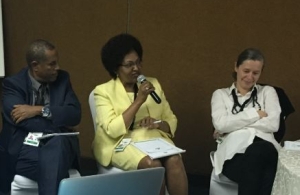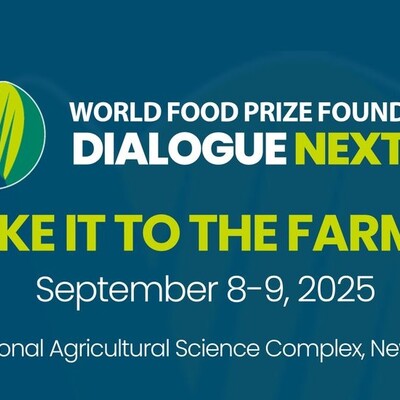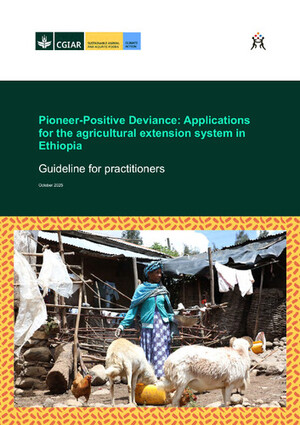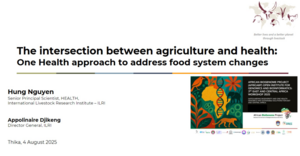
Advocating for livestock, say its supporters, requires stronger narratives as well as robust evidence

Mary Nzomo, the chair of Kenya’s Agriculture County Executive Committee Members Caucus, holding the microphone, flanked by Zena Habtewold Biru and Isabelle Baltenweck. (Photo credit: David Aronson/ILRI)
The International Livestock Research Institute (ILRI) and African Union Commission sponsored a breakout session at the 15th annual Comprehensive Africa Agriculture Development Programme (CAADP) Partnership Platform Meeting held 13 June 2019 in Nairobi, Kenya. The session, moderated by ILRI’s Muthoni Njiru, focused on how investing in livestock can accelerate Africa’s economic transformation. CAADP is Africa’s policy framework for agricultural transformation, wealth creation, food security and economic growth, one of the premiere vehicles on the continent for developing and coordinating agricultural policies.
Joseph Karugia, the coordinator of the Regional Strategic Analysis and Knowledge Support System (ReSAKSS East Africa), set the scene. Livestock, he said, contribute to all 17 of the SDGs and directly to at least 8 of them, including ending hunger and halving poverty. It can also contribute to the Malabo Declaration goal of tripling intra-African trade in agriculture by 2025. Globally, livestock make up five of the top ten agricultural products by economic value. Within Africa, demand is growing rapidly; The African market for animal-source foods is estimated to reach USD 151 billion by 2050, from USD 37 billion in 2010. With smallholders providing 72% of livestock-derived foods in Africa, the potential of local livestock production to encourage economic growth, improve local and regional food security, and reduce poverty is enormous.
However, Karugia cautioned, for livestock to play its rightful role in sustainable development it must receive a proportionate share of public investment in national agricultural investment plans (NAIPs) and official development assistance. Currently, the sector receives limited attention in NAIPs and just a tiny fraction (less than 2.5%) of official development assistance dedicated to agriculture.
Karugia’s presentation was followed by a panel discussion with Mary Nzomo, the chair of Kenya’s Agriculture County Executive Committee Members Caucus; Simplice Nouala, the head of food security for the Rural Economy and Agriculture Division of the African Union; Zena Habtewold Biru, the director of planning and programming at the Ministry of Agriculture and Natural Resources in Ethiopia; and Max Tusiime, a statistician with the Ministry of Agriculture, Animal Industry and Fisheries in Uganda. Sékou-Sangare, the commissioner for agriculture, environment and water resources for the Economic Community of West African States (ECOWAS), provided additional remarks.
Three overarching themes emerged from the panel discussion. First, there was a broad agreement that despite livestock’s importance to African agriculture, investments in the sector haven’t reflected its potential to improve livelihoods and promote higher economic growth. Second, as the African Union’s Simplice Nouala said, “We need to change the narrative.” That is, livestock advocates must do a better job of explaining to both national and international organizations how and why we need to promote livestock in the developing world. And that means, in part, challenging narratives derived from experiences in the rich world that have little applicability or meaning in poorer countries. Third, it’s not enough to simply collate the evidence. Those who work in research organizations must not be content simply to advise governments—they need to work directly with them, for example through the design and implementation of Livestock Master Plans.
ECOWAS commissioner Sékou-Sangare pointed out that ‘apart from oil, livestock is probably the single most important contributor to the region’s GDP.” He said that at the national level, the ministries of forestry, fisheries, agriculture and livestock need to do a better job of working together—because, he said, mixed messages result in no messages being heard. With coordinated action, he said, ‘no sector can do more to reduce poverty’. And he suggested that governments play a role as backstop and guarantor for local banks willing to invest in the livestock value chain.
ILRI’s Isabelle Baltenweck, program leader of the policies, institutions and livelihoods program, concluded the session on an upbeat note: ‘We need to be as energized about the possibilities of livestock as we are frank about its challenges’, she said. ‘Ultimately, it’s about understanding how we can get livestock into the policy dialogue’.
Note: The final communique of the 15th Comprehensive Africa Agriculture Development Programme Partnership Platform Meeting included these two ‘key messages’:
18. Livestock and fisheries contribute substantially to improved livelihoods and higher economic growth in African countries of up to 50 percent of agricultural GDP; yet there is very limited investments in these sector. In this regard, it is critical to change the narrative and factor investment, research and innovation in livestock, fisheries and their value chains so as to achieve food security and Malabo and SDG targets of ending hunger and reducing poverty.
19. Call upon the AUC, AUDA-NEPAD and Partners to incorporate livestock and fisheries indicators, covering financing, productivity, trade and resilience into the Malabo Review Reporting mechanism.



















